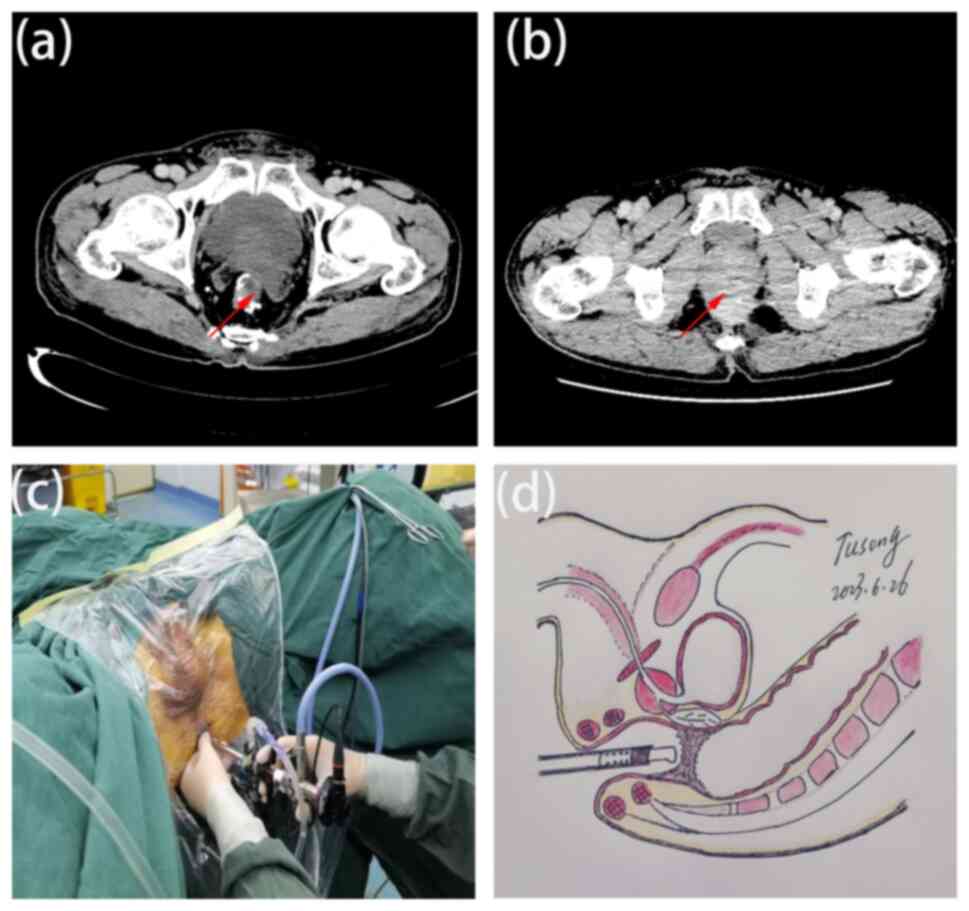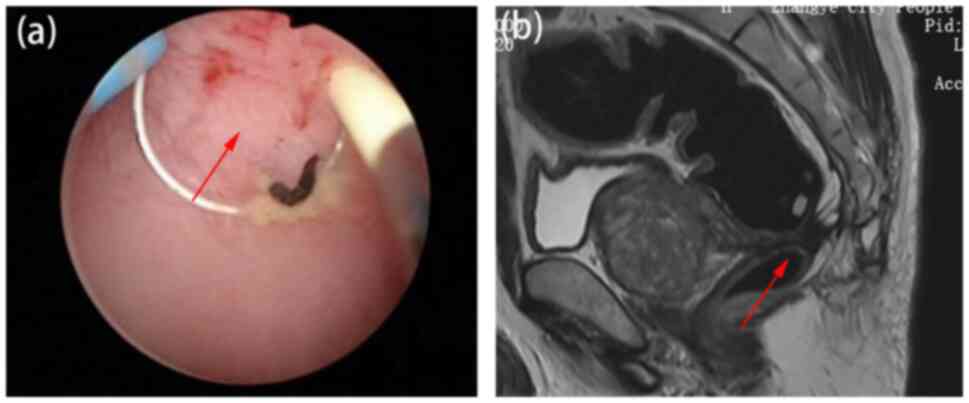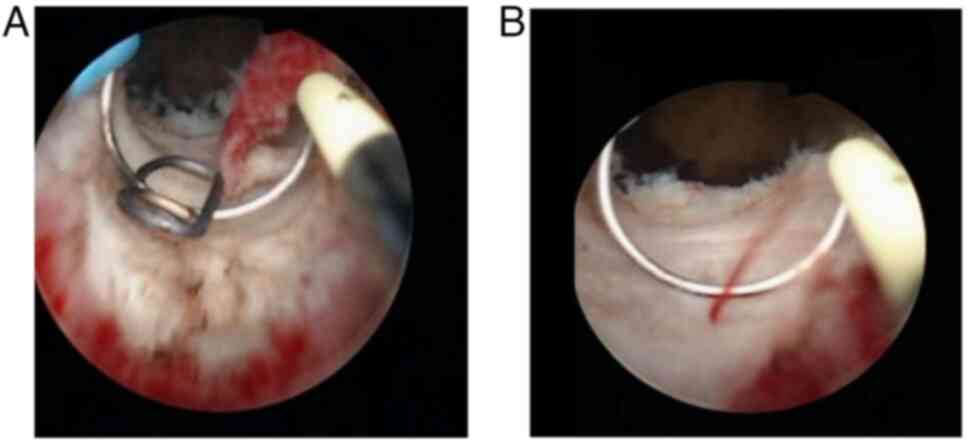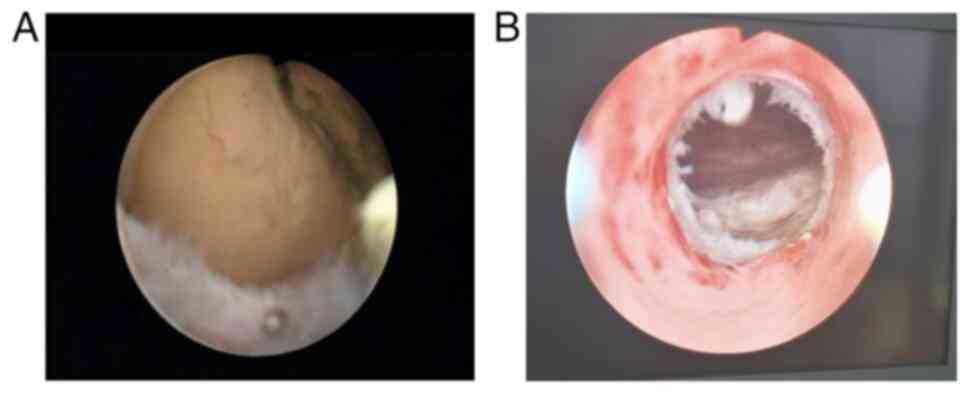Treatment of rectal anastomotic atresia with transurethral prostate resection instrumentation: A report of three cases
- Authors:
- Published online on: March 15, 2024 https://doi.org/10.3892/etm.2024.12491
- Article Number: 202
-
Copyright: © Hu et al. This is an open access article distributed under the terms of Creative Commons Attribution License.
Abstract
Introduction
Rectal cancer is a common malignant tumor of the digestive tract, and low rectal cancer accounts for approximately 70% of all rectal cancers (1). During the previous three decades, the limits of anus preservation have been persistently surpassed owing to the popularization and promotion of total mesorectal excision, the development of laparoscopic technology, the use of endoluminal cutting and stapler, and continuous exploration and innovation of surgeons, accompanied by marked improvements in post-surgical survival period and quality of life for low rectal cancer. With the extensive application of laparoscopy and double staplers in rectal cancer surgery, low anastomosis and mechanical anastomosis are increasingly common in rectal cancer surgery (2,3). Dixon surgery, also known as transabdominal radical resection of rectal cancer, belongs to the category of low anterior resection of the rectum and is the most frequently employed radical resection surgery for rectal cancer, primarily suitable for tumors located ≥6 cm from the anal margin (4). Anastomotic stenosis is a common complication of Dixon surgery for rectal cancer (5), which can be classified as membranous or tubular stenosis. The incidence of anastomotic stenosis following colorectal stapling surgery ranges between 3-30%, which is challenging to manage using conventional approaches (e.g., open surgery and colonoscopy) (6). Severe anastomotic stenosis, to a certain extent, can lead to anastomotic closure, which is classified as the most severe category of anastomotic stenosis, resulting in only a small gap or complete occlusion (7,8). The precise cause of anastomotic stenosis and occlusion remains unknown and may be related to previous radiation therapy, improper use of staplers, postoperative complications, such as anastomotic fistula and local ischemia, and inflammatory bowel disease. Mild stenosis can be treated effectively through methods such as endoscopy, stent placement, and balloon dilation (9). However, for patients with severe anastomotic stenosis or even occlusion, endoscopic treatment is not effective and requires surgical intervention, resulting in increased trauma to the patient. The present study reports three cases of rectal anastomotic atresia where standard colonoscopy was unsuccessful in bypassing or removing the physical obstruction. Notably, the patients showed successful surgical outcomes using a novel minimally invasive approach, wherein prostate resection instrumentation was passed through the anus. All patients provided informed consent prior to the study, and Ethical approval was provided by the Ethics Committee of Hexi University Affiliated Zhangye People's Hospital (Zhangye, China; approval no. B2018-021).
Case report
Case 1
A 72-year-old male underwent Dixon surgery for rectal cancer with a double distal ileostomy (Zhangye People's Hospital Affiliated to Hexi University, Zhangye, China). The patient recovered well, had appropriate stomal output, and was subsequently discharged from the hospital. At six months after the Dixon surgery, the patient requested reinstatement of the anastomosis, and hence, stoma closure was performed in October 2018. At that time, the patient's stoma was unobstructed; however, no rectal examination was performed. Despite uncomplicated anastomosis surgery, the patient developed significant abdominal distension on postoperative day 4 (the patient was still hospitalized), and the patient was diagnosed with rectal obstruction. Digital rectal examination revealed complete obstruction 5 cm from the anal edge, reaching the blind end. Subsequent computed tomography (CT) confirmed rectal anastomotic atresia ~10 mm in length (Fig. 1A). However, attempts at colonoscopic evaluation and management were unsuccessful. Examination via transurethral prostate resection instrumentation revealed complete closure and scar formation of the rectal anastomosis ~5 cm from the anal margin. The central area showed staple exposure owing to the previous anastomotic stapler without evidence of tumor recurrence.
Under general anesthesia, the patient was placed in the lithotomy position, and transurethral prostate resection instrumentation was used to treat the rectal anastomotic atresia (Fig. 1C and D) (10). The instrument was inserted through the anus, and a tunneling incision was made at the center of the atresia. As the sheath traversed the opened segment, discharge of gas and feces confirmed successful decompression. Further electrosurgical resections were made at the scar to widen the diameter to 20 mm. To maintain patency, weekly anastomotic dilatations were performed for 6 months using a 20-mm dilator. Postoperatively, the patient reported the return of normal bowel movements. The patient is followed up every 3 months and currently shows no signs of recurrence. The patient is satisfied with the treatment effect.
Case 2
A 49-year-old man who underwent Dixon surgery (Zhangye People's Hospital Affiliated to Hexi University, Zhangye, China) for rectal cancer with a single distal ileostomy presented with a 1-week history of abdominal pain, bloating and low-grade fever at 8 months postoperatively in January 2022. Although the ileostomy opening was unremarkable, digital rectal examination revealed complete obstruction of the anastomosis 4 cm from the anal edge, with the presence of blood. CT examination confirmed rectal anastomotic atresia of ~13 mm in length (Fig. 1B). However, attempts at colonoscopic evaluation and management were unsuccessful.
Under general anesthesia, the patient underwent treatment for rectal anastomotic atresia via transurethral prostate resection instrumentation (10). The instrument was inserted through the anus, revealing scar formation and complete atresia at 4 cm from the anal margin. Erosion and an unevenly distributed local intestinal cavity were observed, suggesting the possibility of local tumor recurrence. A tunneling incision was made at the center of the closed stoma until the lens sheath opened the closed segment. Gas and fecal liquid were immediately ejected at high pressure, indicating successful decompression. Further electrosurgical resections were made to expand the diameter of the anastomotic stoma to 20 mm, and a rectal drainage tube (Fr24 three-chamber balloon Foley catheter) was retained. Symptoms of abdominal distension and infection after surgery and antibiotic use were resolved postoperatively. Pathological examination of the resected tissue revealed rectal mucinous adenocarcinoma. The patient is followed up every 3 months and is satisfied with the effectiveness of obstruction treatment. At the latest follow-up in August 2023, the patient remained in good health with a satisfactory treatment response. The patient has refused further treatment for recurrent tumors.
Case 3
A 65-year-old man who underwent Dixon surgery with a double distal ileostomy for rectal cancer was admitted 6 months postoperatively for a planned ileostomy closure in May 2023. Digital rectal examination revealed a complete obstruction 5 cm from the anal edge, which was confirmed with a blinded probe. Magnetic resonance imaging (MRI) further showed rectal anastomotic atresia ~8 mm in length (Fig. 2A and B). However, attempts at colonoscopic evaluation and treatment were unsuccessful. Endoscopy using prostate resection instrumentation confirmed complete closure and scar formation of the anastomosis at 5 cm from the anal margin.
Under general anesthesia, the patient was placed in the lithotomy position, and transurethral prostate resection instrumentation was used to treat the rectal anastomotic atresia (10). Prior to the procedure, 1,000 ml methylene blue saline was infused into the distal ileum (only for this case) to visualize the proximal end of the atresia and facilitate dilatation. The instrument was inserted through the anus 30 min after, and a tunneling incision was made at the center of anastomotic closure. As the lens sheath traversed the opened segment, methylene blue solution and feces were discharged, indicating surgical decompression. Further electrosurgical resections were made to widen the anastomotic diameter to 20 mm.
In the present study, preoperative CT or MRI examination was performed to determine the distance from the anastomotic site to the anal margin, the length of anastomotic closure and the degree of proximal intestinal dilation. Utilizing the urological plasma resectoscope, which served as the primary surgical instrument, the rectum and anastomotic site were examined transanally. The surgical direction was determined, and an electrode was used to excavate and open the anastomotic site. During this procedure, 0.9% sodium chloride solution, with a set flushing pressure of 40 cm H2O and an electrocoagulation power of 280/180 W, was used for irrigation. The front end of the circular electrode was angled 30˚ forward for tunneling incisions, and an electrosurgical endoscope was inserted to evaluate the condition of the rectum and anastomotic site, including the degree of stenosis, tumor recurrence, inflammation, bleeding and ulcers. To maintain patency, weekly anastomotic dilatations were performed for 6 months. Furthermore, the patient underwent a reductive ileostomy and was discharged without any complications. On the latest follow-up in August 2023, the patient remained in good health with a satisfactory treatment response.
Discussion
Anastomotic stenosis and leakage are serious complications that negatively impact long-term prognosis and quality of life following anterior resections of the rectum, particularly in low anterior resections (11,12). In cases with severe anastomotic stenosis, permanent colostomy is usually necessitated, substantially diminishing the quality of life (13,14). For patients with rectal cancer who undergo Dixon surgery with a single distal ileostomy, severe postoperative stenosis and atresia can lead to acute closed-loop colonic obstruction, which is life-threatening and often requires emergency treatment (15). Even with preventive double-stoma colostomy or ileostomy, unaddressed complications without obvious symptoms can hinder planned stoma closure.
Anastomotic closure generally represents the most severe form of stenosis. In particular, complete anastomotic closure following laparoscopic low anterior resection for rectal cancer is relatively rare in clinical practice. However, management of this condition is often challenging, resulting in failure of colonoscopic treatment and requiring open surgery (14). Inspired by the urological approaches employed for urethral strictures and atresia, in the present study, prostate resection instrumentation was adopted as a minimally invasive approach to rectal anastomotic atresia. Utilizing preoperative imaging and intraoperative localization of residual anastomotic nails, three patients achieved satisfactory treatment results with a widened diameter of >20 mm.
For cases with narrow gaps or small pore-like channels at the anastomotic site, a guidewire was inserted and marked under microscopic guidance. First, a tunneling incision was made at the 6 o'clock position (lithotomy site). Once the presence of feces and an enlarged proximal rectal cavity were visually confirmed, the anastomotic narrow ring was radially incised at the 12, 3, 6 and 9 o'clock positions (four-point method). Meanwhile, for cases of complete anastomotic closure, a tunneling incision was made from the center of the closure under the guidance of preoperative imaging or residual rectal staples. Electrocoagulation was utilized to control intraoperative bleeding (Fig. 3A and B). For all cases, the presence of stool at the proximal rectum and an enlarged intestinal cavity (Fig. 4A) indicated a successful tunneling incision; otherwise, a four-point radial incision method was used in cases where the proximal cavity was not observed.
For membrane-like closures (<10 mm in length), a single incision can create an anastomotic opening ≥20 mm deep, allowing easy passage of two fingers. In cases of tubular closures (length >11 mm), the anastomosis can be expanded after incision using fingers or dilators to achieve a width of a two fingers or a diameter >20 mm (Fig. 4B). If primary incision and expansion fail to reach sufficient levels, a tunnel can be passed through the lens sheath (>8 mm), and a Fr24 balloon Foley catheter is retained above the closure segment to act as a temporary drainage tube. To prevent prolapse, a 10-ml water injection capsule is used. After a week, a second-stage incision or dilatation is performed to achieve surgical decompression with a rectal anastomosis diameter >20 mm. Following satisfactory incision and dilation, meticulous hemostasis is crucial under electrosurgical endoscopy, involving rectal flushing, drainage of the flushing fluid and collection of excised scar tissue for pathological examination. Postoperative observations for fecal drainage and bleeding are also required. Assuming no bleeding occurs, the drainage tube is removed after 48 h. Subsequent weekly dilations with fingers or dilators maintain the rectal anastomosis diameter at ≥20 mm. Over 3-6 months, the dilation frequency gradually decreases, eventually reaching monthly intervals depending on individual responses.
Preoperative imaging examinations are crucial for occlusion localization. Key indicators include residual anastomotic nails and scarring of the closed anastomosis. In cases with a single ileostomy, a closed-climbing colon obstruction occurs after anastomosis closure. The proximal colon generally accumulates more air and liquid content, resulting in significant distension and enlargement on imaging. Under imaging guidance and aided by key indicators during surgery, it is relatively easy to break through the atresia. In cases with a double-tube ileostomy or transverse colon ostomy, 1,000 ml methylene blue saline can be infused into the colon through the stoma to dilate the proximal colon of the closed anastomosis. This facilitates identification of the correct direction and channel during the operation. For patients with a preventive stoma, it is important to distinguish whether anastomotic atresia or stenosis occurred before or after the planned stoma closure. Neglecting proper assessment before closure can lead to anastomotic rupture and acute bowel obstruction, which would require reoperation. In case 1, anastomotic atresia occurred prior to the planned ileostomy closure. However, due to the surgeon's inexperience and failure to perform colonoscopy or colorectal radiography, acute bowel obstruction developed shortly after the operation. Timely intervention using transurethral prostate resection instrumentation is therefore effective in preventing serious complications.
Endoscopic anastomotic incision offers several advantages over open surgery for digestive tract reconstruction, including less invasiveness, faster recovery and increased convenience (16-18). For suitable cases, laparoscopic monitoring or guided endoscopic incisions can be performed. However, emergency surgical preparation should be performed simultaneously, since intestinal perforation requires prompt management. While commonly utilized, traditional colonoscopes make accurate cutting difficult due to their soft, long bodies and lens instability. Bleeding or excessive intestinal content can also obscure the visual field, which can affect the operation. On the other hand, traditional anoscopes are relatively short and may be insufficiently long to reach the anastomotic site (19). Moreover, they has no connected electrocautery system, making it impossible to perform surgical electrocautery and precise wire-guided expansion. Thus, selecting a stable, directional and easily operable endoscope, such as transurethral prostate resection instrumentation, is crucial for good outcomes. As this instrument has a rigid mirror with directional markings, the endoscopic body is short and easily operable without compromising directionality. Additionally, the use of prostate resection instrumentation for anastomotic atresia is simpler and more effective than colonoscopy. First, there is a clear field of view, owing to the high pressure of the flushing fluid, since prostate resection instrumentation has inlet and outlet ports that allow continuous flushing. Second, guidewire catheters can easily be inserted in the instrument, allowing scar electrocautery, electrocoagulation and hemostasis. The technical principle of prostate resection instrumentation is that the radiofrequency electrode transmits high-energy heat to the target tissue, causing rapid carbonization of tissue cells, water evaporation inside the cells, and rapid decomposition and vaporization. More specifically, the radio frequency electrode can quickly heat the tissue to contact temperatures >400˚C, resulting in cutting vaporization along the trajectory of the electrode plus the hot spot. Heat penetration can produce a 2-3 mm solidification layer on the cut tissue, resulting in good coagulation and hemostatic effects (20).
Since prostate resection instrumentation is readily available and commonly used in hospitals in China, its implementation for rectal anastomotic atresia is feasible (21). Adapting its use for rectal surgery requires no technological modifications, except a shift in the surgery site. In this procedure, the atresic lesion is located and incised at the distal end of the peritoneal fold. Precise incisions and blunt dissections should therefore be performed to ensure minimal intestinal damage and bleeding during surgery. Based on our experience with these three cases, we consider that the treatment of rectal anastomotic atresia with transanal prostate resection instrumentation is a safe and effective minimally invasive approach. The use of standard instrumentation further highlights its potential as a novel approach to resolve the blockages.
Acknowledgements
Not applicable.
Funding
Funding: This study was funded by grants from the President Fund Innovation Team Project of Hexi University (no. CXTD2022012) and the Hexi University 13th Science and Technology Innovation Project (no. 127).
Availability of data and materials
The data generated in the present study are included in the figures of this article.
Authors' contributions
ZH, ST, JQ and JY contributed to the conception or design of the study. ZH and YQ wrote the manuscript and acquired and analyzed data for the study. XW and ST performed the operation. XW, JQ, and ST agree to be accountable for all aspects of the work in ensuring that questions related to the accuracy or integrity of any part of the work are appropriately investigated and resolved. ST and JY confirm the authenticity of all the raw data and performed the manuscript review. All authors have read and approved the manuscript.
Ethics approval and consent to participate
Ethical approval was provided by the Ethics Committee of Hexi University Affiliated Zhangye People's Hospital (approval no. B2018-021). The study followed the terms set out by the Declaration of Helsinki. The patients provided written informed consent for participation.
Patient consent for publication
Written consent was obtained for publication of the patients' images in this case report.
Competing interests
The authors declare that they have no competing interests.
References
|
Wilkinson N: Management of rectal cancer. Surg Clin North Am. 100:615–628. 2020.PubMed/NCBI View Article : Google Scholar | |
|
Mathew R: Radical surgery versus organ preservation for early-stage rectal cancer. Lancet Gastroenterol Hepatol. 6(263)2021.PubMed/NCBI View Article : Google Scholar | |
|
Planellas P, Farrés R, Cornejo L, Rodríguez-Hermosa JI, Pigem A, Timoteo A, Ortega N and Codina-Cazador A: Randomized clinical trial comparing side to end vs end to end techniques for colorectal anastomosis. Int J Surg. 83:220–229. 2020.PubMed/NCBI View Article : Google Scholar | |
|
Zheng XC, Su JB and Zheng JJ: Risk assessment of rectal anastomotic leakage (RAREAL) after DIXON in non-emergency patients with rectal cancer. BMC Gastroenterol. 23(343)2023.PubMed/NCBI View Article : Google Scholar | |
|
Hu X, Guo P, Zhang N, Guo G, Li B, Liu Y, Niu J and Wang G: Nomogram for benign anastomotic stricture after surgery for rectal cancer. Asian J Surg. 46:111–119. 2023.PubMed/NCBI View Article : Google Scholar | |
|
Forshaw MJ, Maphosa G, Sankararajah D, Parker MC and Stewart M: Endoscopic alternatives in managing anastomotic strictures of the colon and rectum. Tech Coloproctol. 10:21–27. 2006.PubMed/NCBI View Article : Google Scholar | |
|
Lu G, Li J, Ren M, Ma F, Sun X, Lv Y and He S: Endoscopy-assisted magnetic compression anastomosis for rectal anastomotic atresia. Endoscopy. 53:E437–E439. 2021.PubMed/NCBI View Article : Google Scholar | |
|
Kurashima M, Joshi S, Sobrino J and Blewett C: Rectal atresia treated via a transanal and posterior sagittal approach: A report of two cases. Cureus. 15(e38694)2023.PubMed/NCBI View Article : Google Scholar | |
|
Kraenzler A, Maggiori L, Pittet O, Alyami MS, la Denise JPA and Panis Y: Anastomotic stenosis after coloanal, colorectal and ileoanal anastomosis: What is the best management? Colorectal Dis. 19:O90–O96. 2017.PubMed/NCBI View Article : Google Scholar | |
|
Zhang Z, Hu Z, Qin Y, Qian J, Tu S and Yao J: Application of transurethral prostate resection instrumentation for treating low rectal anastomotic leakage: A pilot study. Cancer Manag Res. 14:1987–1994. 2022.PubMed/NCBI View Article : Google Scholar | |
|
Lamazza A, Fiori E, Schillaci A, Sterpetti AV and Lezoche E: Treatment of anastomotic stenosis and leakage after colorectal resection for cancer with self-expandable metal stents. Am J Surg. 208:465–469. 2014.PubMed/NCBI View Article : Google Scholar | |
|
Guyton KL, Hyman NH and Alverdy JC: Prevention of perioperative anastomotic healing complications: Anastomotic stricture and anastomotic leak. Adv Surg. 50:129–141. 2016.PubMed/NCBI View Article : Google Scholar | |
|
Schlegel RD, Dehni N, Parc R, Caplin S and Tiret E: Results of reoperations in colorectal anastomotic strictures. Dis Colon Rectum. 44:1464–1468. 2001.PubMed/NCBI View Article : Google Scholar | |
|
Zhang B, Zhuo GZ, Tian L, Zhao K, Zhao Y, Zhao YJ, Zhu J, Zhang T and Ding JH: Risk factors of coloanal anastomotic stricture after laparoscopic intersphincteric resection for low rectal cancer. Zhonghua Wei Chang Wai Ke Za Zhi. 22:755–761. 2019.PubMed/NCBI View Article : Google Scholar : (In Chinese). | |
|
Sali PA, Pilania V, Sutar S, Krishna K, Ghetla S and Shetty T: Total colectomy in a gangrenous large bowel due to a rare double closed loop obstruction. Int J Surg Case Rep. 17:1–4. 2015.PubMed/NCBI View Article : Google Scholar | |
|
Inoue T, Shichijo S, Yasui M, Takeuchi Y, Michida T and Ishihara R: Endoscopic incision and balloon dilation using the rendezvous technique for complete anastomotic obstruction after rectal low-anterior resection. Endoscopy. 54:E90–E91. 2022.PubMed/NCBI View Article : Google Scholar | |
|
Wang S, Wan J, Li Z, Long C, Zhang R, Luo Y, Han Z and Yan J: Comparison of the efficacy of endoscopic radial incision and cutting procedure and endoscopic balloon dilatation for benign anastomotic stricture after low anterior resection combined with preventive loop ileostomy in rectal cancer. Dis Colon Rectum. 20:1392–1401. 2023.PubMed/NCBI View Article : Google Scholar | |
|
Zhou W, Xia L, Wang Z, Cao G, Chen L, Chen E, Zhang W and Song Z: Transanal minimally invasive surgery for rectal anastomotic stenosis after colorectal cancer surgery. Dis Colon Rectum. 65:1062–1068. 2022.PubMed/NCBI View Article : Google Scholar | |
|
Yan P, Qin Y, Zhang Z, Xu W, Qian J, Tu S and Yao J: Application of prostate resection endoscopy for treating acute obstruction associated with rectal cancer. J Cancer. 13:1679–1684. 2022.PubMed/NCBI View Article : Google Scholar | |
|
Barba M, Fastenmeier K and Hartung R: Electrocautery: Principles and practice. J Endourol. 17:541–555. 2003.PubMed/NCBI View Article : Google Scholar | |
|
Zeng XT, Jin YH, Liu TZ, Chen FM, Ding DG, Fu M, Gu XQ, Han BM, Huang X, Hou Z, et al: Clinical practice guideline for transurethral plasmakinetic resection of prostate for benign prostatic hyperplasia (2021 Edition). Mil Med Res. 9(14)2022.PubMed/NCBI View Article : Google Scholar |













